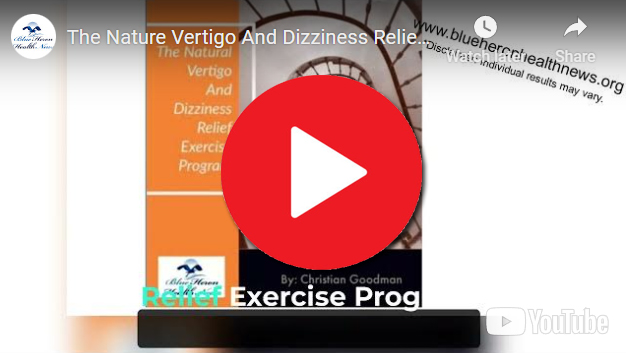The Nature Vertigo And Dizziness Relief Exercise Program™ Created by Christian Goodman, Vertigo and Dizziness Program is a designed to help stop vertigo and dizziness once and for all. Medical practitioner don’t know the exact cure for this condition but this program will show you exactly what you need to make this painful condition a thing of the past. This program has recommended a set of simple head exercises that help cure this condition. The remedy that the author has recommended are completely natural meaning that you won’t use medication or undergo through life-threatening surgical procedure. The set of exercises that he has recommended are easy and can be performed by anyone regardless of where they are or their current physical shape.
How can ear infections cause vertigo?
Ear infections can cause vertigo by affecting the structures of the inner ear responsible for balance and spatial orientation. Vertigo is a sensation of spinning or dizziness that can result from disturbances in the vestibular system of the inner ear. Here’s a detailed explanation of how ear infections can lead to vertigo:
1. Types of Ear Infections
– Otitis Externa (Outer Ear Infection)
- Infection of the external auditory canal, commonly known as swimmer’s ear. It rarely causes vertigo.
– Otitis Media (Middle Ear Infection)
- Infection of the middle ear space, typically occurring behind the eardrum. It can occasionally cause balance issues but not typically vertigo unless complications arise.
– Labyrinthitis (Inner Ear Infection)
- Inflammation of the labyrinth, which includes the cochlea (hearing) and the vestibular system (balance). Labyrinthitis often results in vertigo.
– Vestibular Neuritis
- Inflammation of the vestibular nerve, which carries balance signals from the inner ear to the brain. It causes vertigo without affecting hearing.
2. Mechanisms of Vertigo in Ear Infections
– Labyrinthitis
- Direct Inflammation: Infection can directly inflame the labyrinth, affecting both the cochlear and vestibular portions. This inflammation disrupts the normal functioning of the vestibular system, leading to vertigo.
- Fluid Accumulation: Inflammatory processes can lead to the accumulation of fluid in the inner ear, which can alter the pressure and composition of the endolymph (the fluid within the labyrinth), disturbing balance signals.
– Vestibular Neuritis
- Nerve Inflammation: The vestibular nerve becomes inflamed, disrupting the transmission of balance information from the inner ear to the brain. This leads to a mismatch of sensory inputs, causing vertigo.
– Otitis Media
- Pressure Changes: Middle ear infections can cause pressure changes that may affect the inner ear, indirectly leading to vertigo.
- Labyrinthine Fistula: Rarely, severe or chronic middle ear infections can create a small tear (fistula) in the membranes of the inner ear, causing perilymph (another fluid in the inner ear) to leak into the middle ear, resulting in vertigo.
- Spread of Infection: In rare cases, the infection can spread from the middle ear to the inner ear, causing labyrinthitis.
3. Symptoms of Vertigo from Ear Infections
– Spinning Sensation
- A feeling that you or your surroundings are spinning or moving.
– Balance Problems
- Difficulty maintaining balance, which can lead to unsteadiness or falls.
– Nausea and Vomiting
- Often associated with severe vertigo.
– Hearing Loss
- Sensorineural hearing loss in the affected ear (common in labyrinthitis).
– Tinnitus
- Ringing, buzzing, or other noises in the affected ear.
4. Diagnosis
– Clinical Examination
- A thorough history and physical examination to assess symptoms and possible causes.
- Otoscopic examination to check for signs of ear infection.
– Hearing Tests
- Audiometry to evaluate hearing loss, which can help differentiate between labyrinthitis and vestibular neuritis.
– Balance Tests
- Electronystagmography (ENG) or videonystagmography (VNG) to assess eye movements and vestibular function.
- Vestibular evoked myogenic potentials (VEMP) to evaluate the function of the otolith organs.
– Imaging
- MRI or CT scans may be used to rule out other causes of vertigo, such as tumors or structural abnormalities.
5. Treatment
– Medications for Infection
- Antibiotics: For bacterial infections. Oral antibiotics for middle ear infections, and intravenous antibiotics for severe or spreading infections.
- Antivirals: Sometimes used if a viral infection is suspected, though not typically necessary for vestibular neuritis.
– Medications for Symptom Relief
- Antihistamines: Meclizine or dimenhydrinate to reduce vertigo.
- Antiemetics: Promethazine or ondansetron for nausea and vomiting.
- Corticosteroids: Prednisone to reduce inflammation in vestibular neuritis or severe labyrinthitis.
– Vestibular Rehabilitation Therapy (VRT)
- Physical therapy exercises designed to improve balance and reduce dizziness by helping the brain adapt to changes in the vestibular system.
– Supportive Care
- Rest and hydration to aid recovery.
- Avoiding activities that can worsen symptoms, such as sudden head movements.
Conclusion
Ear infections can cause vertigo by affecting the inner ear structures responsible for balance, leading to inflammation, fluid accumulation, and disruptions in the transmission of balance information. Labyrinthitis and vestibular neuritis are common inner ear infections that cause vertigo, while severe middle ear infections can sometimes lead to complications that result in vertigo. Proper diagnosis and treatment, including medications for infection and symptom relief, as well as vestibular rehabilitation therapy, are crucial for managing vertigo associated with ear infections.
The Nature Vertigo And Dizziness Relief Exercise Program™ Created by Christian Goodman, Vertigo and Dizziness Program is a designed to help stop vertigo and dizziness once and for all. Medical practitioner don’t know the exact cure for this condition but this program will show you exactly what you need to make this painful condition a thing of the past. This program has recommended a set of simple head exercises that help cure this condition. The remedy that the author has recommended are completely natural meaning that you won’t use medication or undergo through life-threatening surgical procedure. The set of exercises that he has recommended are easy and can be performed by anyone regardless of where they are or their current physical shape.

